The spinning continues (as does the Christmas knitting, but that isn't yet bloggable)...
First off the spindle was a braid of merino / silk blend dyed by Old Maiden Aunt in the colourway 'teal deer'.
I spun this on my heavy (45g) bottom-whorl spindle as a light fingering weight single, then tried something new with the plying. Instead of chain plying directly from one spindle to another, I chained the single into a plying ball. This took ages to do (and much help from the Resident Radiologist), but it did allow me to stop and start with the plying much more easily than if I'd been plying directly.
The finished yarn was a light DK weight and I got about 150m in the skein.
Next up was a rainbow felting sample pack from Diva Design studios in Moray. The fibre wasn't listed, but a bit of detective work makes me think it was mostly merino with an occasional bit of silk blended in.
I spun this on a much lighter modular spindle, taking the single off on three bobbins, then chain plying directly from the bobbins onto my heavy spindle, joining the single as I went.
I've ended up with 200m of light fingering weight 3 ply in a lovely rainbow.
On reflection, I think that a plying ball is really useful for making a two ply, or a three ply from individual singles, but the work involved in putting a chained three ply onto the ball is probably not worth any time and convenience saved during plying.
Monday, 28 November 2011
Tuesday, 8 November 2011
From (almost) first principles
I've been spinning for a while now... I first bought a drop spindle at Woolfest in 2008, then went up to Twist Fibre Craft Studio in Newburgh to have a beginners lesson. My spinning got steadily better and I produced some yarns that I was fairly proud of, but I never used them.
At Woolfest 2009, I bought another spindle so I could ply from the spindle carrying the single, onto the second spindle and a bag of beautiful 80% merino / 20% silk roving. I spun half of it up almost immediately and then never got going the other half (my intention was to ply as a 2-ply).
Roll forward a couple of years (and one small child) and The Yarn Cake in Glasgow started a Spin Sunday on the first Sunday of the month. This coincided nicely with my fingers starting to get itchy for spinning again, so I hunted down the half bag of roving and got going again.

This time, I was bitten thoroughly by the bug and within a few days, I'd finished spinning the second half of the fibre. I changed my mind about plying as a 2 ply, as I prefer the roundness of a 3 ply, so I chain plied both of my singles and ended up with two lovely skeins of approximately fingering weight yarn.
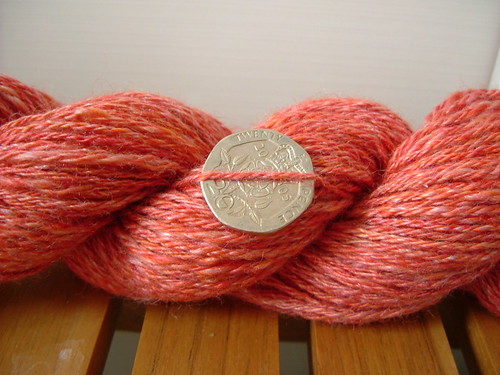
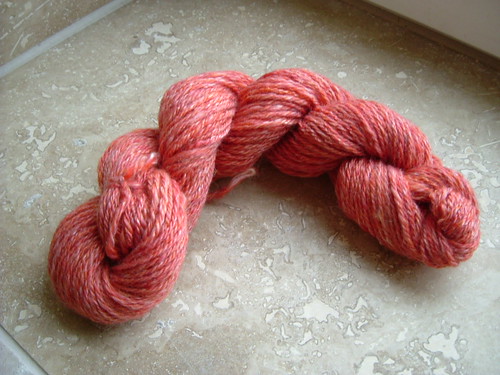
I immediately knitted the longer skein up into a scarf for my daughter.
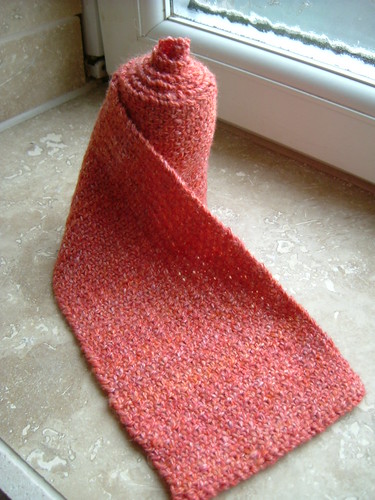
It's a plain linen-stitch scarf using surprisingly large needles (5.5mm) as linen stitch is quite dense.
The fabric is wonderfully flat and has a good drape and really does look woven.
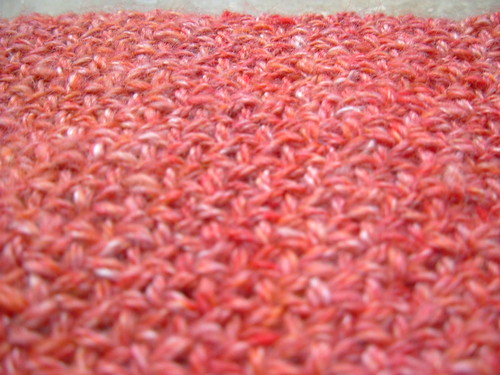
The other skein is likely to become a pair of mittens, or maybe a hat.
At Woolfest 2009, I bought another spindle so I could ply from the spindle carrying the single, onto the second spindle and a bag of beautiful 80% merino / 20% silk roving. I spun half of it up almost immediately and then never got going the other half (my intention was to ply as a 2-ply).
Roll forward a couple of years (and one small child) and The Yarn Cake in Glasgow started a Spin Sunday on the first Sunday of the month. This coincided nicely with my fingers starting to get itchy for spinning again, so I hunted down the half bag of roving and got going again.

This time, I was bitten thoroughly by the bug and within a few days, I'd finished spinning the second half of the fibre. I changed my mind about plying as a 2 ply, as I prefer the roundness of a 3 ply, so I chain plied both of my singles and ended up with two lovely skeins of approximately fingering weight yarn.


I immediately knitted the longer skein up into a scarf for my daughter.

It's a plain linen-stitch scarf using surprisingly large needles (5.5mm) as linen stitch is quite dense.
The fabric is wonderfully flat and has a good drape and really does look woven.

The other skein is likely to become a pair of mittens, or maybe a hat.
Thursday, 13 October 2011
Stranded Mittens - Chrysanthemums
I've been bitten quite severely by the stranded colourwork bug recently and these mittens were the culprit! I saw them on Knitty when they were published and just knew I had to try them.
I'm not proficient at knitting with a different colour in each hand with DPNs, though I do manage it with longer straight needles, so the first mitten was an agony of pick one colour up and knit a stitch, pick the other colour up and knit a stitch (especially on the cuff). In addition to this , although I thought I was spacing my stitches well enough, once I finished, I found the work was puckered and that the floats were, in general, not long enough.
There is a clear improvement between the first and second mitten and they're lovely and soft and warm to wear. In addition, they go perfectly with my Beret de Printemps, though this was not intentional!
I love the traditional Scandinavian palm, thumb and striped cuff, but I'm not sure I'd bother with the picot edge again.
Details:
Yarn: Artesano Alpaca 4ply
Needles: 2.25mm DPNs
Pattern: Chrysanthemum by Heather Desserud, published in Knitty, Winter 2010
Since knitting these, I've finished a second pair of stranded mittens that are Christmas knitting, so not for blogging until January, and am contemplating a stranded colourwork jumper....
I'm not proficient at knitting with a different colour in each hand with DPNs, though I do manage it with longer straight needles, so the first mitten was an agony of pick one colour up and knit a stitch, pick the other colour up and knit a stitch (especially on the cuff). In addition to this , although I thought I was spacing my stitches well enough, once I finished, I found the work was puckered and that the floats were, in general, not long enough.
There is a clear improvement between the first and second mitten and they're lovely and soft and warm to wear. In addition, they go perfectly with my Beret de Printemps, though this was not intentional!
I love the traditional Scandinavian palm, thumb and striped cuff, but I'm not sure I'd bother with the picot edge again.
Details:
Yarn: Artesano Alpaca 4ply
Needles: 2.25mm DPNs
Pattern: Chrysanthemum by Heather Desserud, published in Knitty, Winter 2010
Since knitting these, I've finished a second pair of stranded mittens that are Christmas knitting, so not for blogging until January, and am contemplating a stranded colourwork jumper....
Thursday, 29 September 2011
A hit and a miss
After receiving a hint that I needed a new beret and cowl set, I went looking for patterns. There are several lovely beret patterns in my Ravelry queue - Gretel, Ishbel and Snapdragon, all by Ysolda Teague, but it was Beret de Printemps by Jeni Chase that really caught my attention.
I had two balls of Rowan Felted Tweed DK in my stash in a lovely spring green that seemed just right for a spring beret, so off I knitted.
I didn't find the pattern very well written, there are a couple of points in the chart when the next step is not altogether clear, but after a false-start or two, I got there.
The miracle of blocking turned a rather unpromising looking blob into a respectable looking beret.
I had yarn left over, so I used the stitch pattern to make a little cowl to match.

Details:
Pattern: Beret de Printemps by Jeni Chase,
Yarn: Rowan Felted Tweed DK in colour 146 (Herb)
Needles: 3.5mm and 4mm DPNs
I had two balls of Rowan Felted Tweed DK in my stash in a lovely spring green that seemed just right for a spring beret, so off I knitted.
I didn't find the pattern very well written, there are a couple of points in the chart when the next step is not altogether clear, but after a false-start or two, I got there.
The miracle of blocking turned a rather unpromising looking blob into a respectable looking beret.
I had yarn left over, so I used the stitch pattern to make a little cowl to match.
Details:
Pattern: Beret de Printemps by Jeni Chase,
Yarn: Rowan Felted Tweed DK in colour 146 (Herb)
Needles: 3.5mm and 4mm DPNs
The beret is a real hit - it fits well, the colour is lovely and it's warm. The cowl is sadly a miss. It's too short and tends to roll down and end up as a round knitted band around my neck. I think it could have done with being a few pattern repeats bigger. It will be frogged and returned to stash.
Labels:
Beret de Printemps,
frogging,
Rowan Felted Tweed DK
Wednesday, 30 March 2011
Little Green Jumper
Another post-baby knit, but Imogen has almost grown out of it already...

The pattern is Placket Neck Pullover by Joelle Hoverson published in Last Minute Knitted Gifts. I knitted this in Debbie Bliss Pure Cotton on 4mm needles. It took just under 4 balls.

I hate this yarn with a passion - I originally bought it to make a summer cardigan for myself, but the yarn has on average 2 knots per ball and starts to look a bit rough as you handle it so I ripped the cardi. Although I couldn't bear the idea of putting in the work to make something for myself out of such a poor quality yarn because I did't think it would wear well, the effort / outcome balance is different for a baby garment because they wear their clothes for so little time before outgrowing them.
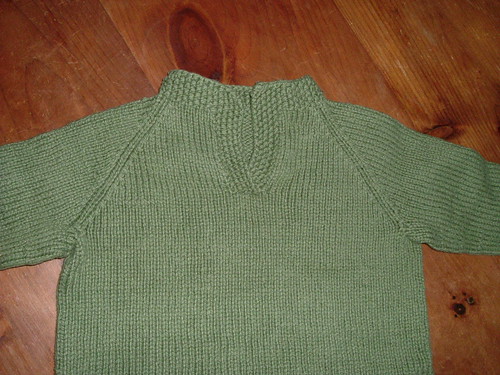
It worked out really well and was perfect for Imogen. She doesn't like cardigans much so a jumper suited her better over the winter. I didn't put the buttons on as things tend to ride up on her and I though that they would end up wedged under her chin!
The garment is well constructed with minimal seaming (which I always prefer) and the pattern is beautifully written.

The pattern is Placket Neck Pullover by Joelle Hoverson published in Last Minute Knitted Gifts. I knitted this in Debbie Bliss Pure Cotton on 4mm needles. It took just under 4 balls.

I hate this yarn with a passion - I originally bought it to make a summer cardigan for myself, but the yarn has on average 2 knots per ball and starts to look a bit rough as you handle it so I ripped the cardi. Although I couldn't bear the idea of putting in the work to make something for myself out of such a poor quality yarn because I did't think it would wear well, the effort / outcome balance is different for a baby garment because they wear their clothes for so little time before outgrowing them.

It worked out really well and was perfect for Imogen. She doesn't like cardigans much so a jumper suited her better over the winter. I didn't put the buttons on as things tend to ride up on her and I though that they would end up wedged under her chin!
The garment is well constructed with minimal seaming (which I always prefer) and the pattern is beautifully written.
Thursday, 10 March 2011
Simple socks and not-so-simple socks...
It would seem that the reason I'm not blogging as regularly as I would like to is not that I'm not knitting, but that I'm not taking photos as regularly any more (and apparently I can't blog without photos).
At the weekend I managed to get the camera out and get up to date with my projects, so here we have the first project I knitted after picking up the needles again, and something considerably more tricky.
Socks for the Resident Radiologist:

My standard top-down pattern with heel-flap heel. The yarn is Fortissima Colori Socka Color in an Autumnal colourway that the RR chose many moons ago. Knitted on 2.25mm DPNs.
Socks for the Knitter:
These are Skew by Lana Holden, published in Knitty. The yarn is some lovely Trekking XXL. They were knitted on 2.5mm DPNs.
 Thanks to some spectacular denial on my part while I was knitting not just the first, but also the second sock in this pair, they were considerably too long for my feet... but too narrow for the RR's heel...
Thanks to some spectacular denial on my part while I was knitting not just the first, but also the second sock in this pair, they were considerably too long for my feet... but too narrow for the RR's heel...
What to do? I couldn't bring myself to rip them and alter the length as they're knitted toe-up so I would have to pretty much start again.
After much musing, I decided to cut a section out of the foot part of each sock and graft the two parts back together. Using a 2mm needle, I picked up the row of stitches either side of the section I wanted to lose...

snipped a stitch and unravelled the yarn to separate the two parts...


then ripped to get rid of the extra rows.
After that, it was just a matter of grafting... and grafting... and grafting...
They now fit beautifully. I ended up taking almost two inches out of each sock (that's how bad the denial was). Despite spending a huge amount of time knitting these socks (and then performing knitty surgery on them), I still can't get over how strange and beautiful the heels are.
I ended up taking almost two inches out of each sock (that's how bad the denial was). Despite spending a huge amount of time knitting these socks (and then performing knitty surgery on them), I still can't get over how strange and beautiful the heels are.

I don't think I'll knit these again. I'm glad I've done them and the (final) fit is really good, but they're not relaxing knitting, they're in no way intuitive (even for my maths-oriented brain) and I still can't get my head around how the heels actually work!
At the weekend I managed to get the camera out and get up to date with my projects, so here we have the first project I knitted after picking up the needles again, and something considerably more tricky.
Socks for the Resident Radiologist:
My standard top-down pattern with heel-flap heel. The yarn is Fortissima Colori Socka Color in an Autumnal colourway that the RR chose many moons ago. Knitted on 2.25mm DPNs.
Socks for the Knitter:
These are Skew by Lana Holden, published in Knitty. The yarn is some lovely Trekking XXL. They were knitted on 2.5mm DPNs.
What to do? I couldn't bring myself to rip them and alter the length as they're knitted toe-up so I would have to pretty much start again.
After much musing, I decided to cut a section out of the foot part of each sock and graft the two parts back together. Using a 2mm needle, I picked up the row of stitches either side of the section I wanted to lose...
snipped a stitch and unravelled the yarn to separate the two parts...
then ripped to get rid of the extra rows.
After that, it was just a matter of grafting... and grafting... and grafting...
They now fit beautifully.
I don't think I'll knit these again. I'm glad I've done them and the (final) fit is really good, but they're not relaxing knitting, they're in no way intuitive (even for my maths-oriented brain) and I still can't get my head around how the heels actually work!
Subscribe to:
Comments (Atom)








